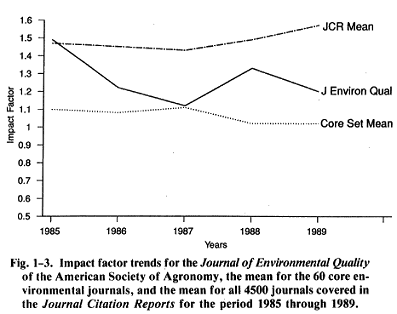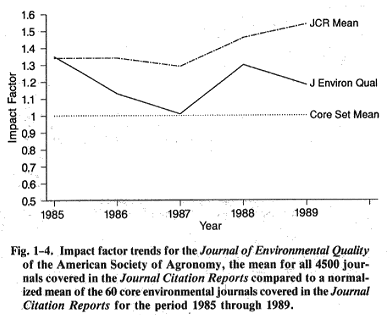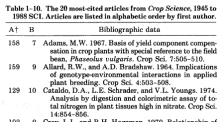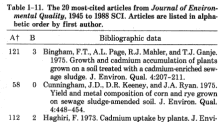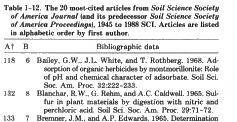ABSTRACT
Citation data for 66 agronomic and soil science journals indexed in
the 1989 Science Citation Index (SCI) are examined to determine how publications
of the American Society of Agronomy compare with others in the field. For
these �core� journals, rankings by number of articles, citations, and impact
factors are presented. The journals are then treated as if they comprised
a single �Macrojournal of Agronomy� to see what publications it cited and
what it was cited by. Highest impact articles and most active research
fronts in agronomy and the soil sciences are also presented. Based on these
data, 11 journals are identified as occupying a prominent position in the
field.
It is a pleasure and an honor to be here today, and to address this
group on the effectiveness of American Society of Agronomy (ASA) journals.
There are usually two reasons why I am invited to speak before professional
societies or groups of journal editors and publishers; they want to know
if their journals are strong or weak. When Bob Sojka and Hank Mayland invited
me to this meeting (R.E. Sojka and H.F. Mayland, 1989, personal communication),
they were pretty explicit about their motives. They wanted to know if the
ASA journals are having a real impact or, to quote Bob and Hank, �are we
only talking to ourselves?� In particular, they asked whether �citation
analysis bears out the ASA�s perceptions that our journals are the premier
journals of agronomic and resource management,� (R.E. Sojka and H.F. Mayland,
1989, personal communication).
I am happy to say that the answer to this question is yes. As will be
illustrated in this presentation, the ASA journals indexed in the Institute
for Scientific Information�s (ISI) 1989 edition of the SCI appear to be
among the most �influential� in the field of agronomy and soil science
by various citation indicators.
CITATION DATA FOR JOURNAL ANALYSIS
Our series of journal citation studies, which now number over 50, are
derived from ISI�s SCI database, a multidisciplinary and comprehensive
index to the leading international research literature. The SCI is distinct
from other major secondary information services in several ways. For example,
the SCI reflects the interdisciplinary nature of research by covering virtually
all scientific disciplines rather than being limited to a single one.
Also, the SCI provides complete cover-to-cover indexing of every type
of item published in a journal�not just research articles, reviews, and
notes but also letters, er rata, corrections and retractions, editorials,
and so on. The ISI studies have indicated that many of these so-called
�source items� can be cited as often as, and some-times
even more often than research articles (1).
This brings us to the SCI�s most unique distinction� that it fully indexes
not only every source item but also all the references they cite. Citations
forge links between current citing papers and earlier cited works. On a
microlevel, these links are highly useful for information retrieval. They
allow researchers to move backward and forward in time to identify publications
relevant to their specific interest.
On a macrolevel, citations define broad relationships in the literature
as a whole. Increasingly, these data are being used for descriptive and
evaluative purposes to determine, for example, how journals or institutions
or nations compare in terms of volume and impact of pub-lications; what
are the hottest articles and research fronts, and so on.
In this presentation, we�ll survey the �lay of the land� in the agronomic
and soil science literature and identify the most � �fruitful� journals.
We�ll start with a group of 66 agronomic/soil science journals indexed
in the 1989 SCI, and present various rankings by articles, citations, and
impact. Then we�ll treat the 66 agronomic/soil journals as if they comprised
one large Macrojournal of Agronomy. This will allow us to identify the
journals it cited most frequently and those it was most cited by. We�ll
also present the specialty areas in which the ASA journals dominate, as
well as identify their most-cited articles.
CORE JOURNALS OF AGRONOMY AND SOIL SCIENCE
 Table
1-1 lists 66 agronomic and soil science journals covered in the Journal
Citation Reports (JCR) volumes of the 1989 SCI, in alphabetic order by
publisher and showing their first years of publication. The oldest is Journal
of Agronomy and Crop Science/Zeitschrift für Acker- und Pflanzenbau,
which was launched in 1853. Others are: Journal of Agricultural Science
(1905);
Transactions
of the ASAE (American Society of Agricultural Engineers) and the ASA�s
Agronomy Journal (both 1907); and the Journal of Economic Entomology
(1908).
Table
1-1 lists 66 agronomic and soil science journals covered in the Journal
Citation Reports (JCR) volumes of the 1989 SCI, in alphabetic order by
publisher and showing their first years of publication. The oldest is Journal
of Agronomy and Crop Science/Zeitschrift für Acker- und Pflanzenbau,
which was launched in 1853. Others are: Journal of Agricultural Science
(1905);
Transactions
of the ASAE (American Society of Agricultural Engineers) and the ASA�s
Agronomy Journal (both 1907); and the Journal of Economic Entomology
(1908).
The most recent journals are: Biology and Fertility of Soils (1985),
Agriculture
Ecosystems and Environment (1983), Crop Protection (1982), Biomass
(1981), and Soil and Tillage Research (1980).
Nineteen of these journals are published in the USA. These include an
English translation of Soviet Soil Science. Sixteen are from the United
Kingdom (UK), five of which are published by Elsevier. Ten are published
in the Netherlands (six by Elsevier), followed by Germany with five. Australia
and Japan each have four; Canada, New Zealand, and Sweden account for two
each; and France and Italy each have one.
Three ASA journals are included here�the Agronomy Journal, Crop Science,
and the Soil Science Society of America Journal. Another ASA journal, the
Journal of Environmental Quality, is also covered in the SCI under the
environmental science subject category. Data on this journal are presented
later, but our focus will be on the agronomic and soil science journal
set.
Now let�s see which of these agronomic and soil science journals are
the most productive, in terms of the number of articles published in 1989.
LARGEST CORE JOURNALS OF AGRICULTURE AND THE SOIL SCIENCES
Table 1-2 shows 22 journals that published at least 100 research articles,
review articles, and technical notes in 1989. (These source items will
simply be referred to here as articles.) The three ASA journals are highlighted
by daggers and rank among the top 10 journals by productivity . The
largest journal with 625 articles is Agriculturalal and Biological Chemistry,
published by the Japan Society of Bioscience and Biotechnology, followed
by the ASA�s Crop Science with 427.
It is interesting to note that the 66 agronomic and soil science journals
published a total of 6608 articles in 1989. The first four journals in
Table 1-2 account for 26% of the total, and the
first 11 account for over 50% . This is merely another illustration of
the well-known Bradford and Zipf distributions and various other statistical
patterns (2). These patterns will also apply to the
concentration of citations in a small number of journals.
MOST-CITED CORE JOURNALS
Table 1-3 shows 16 agronomic and soil science journals that received
at least 1000 citations in 1989. Again, the ASA journals are indicated
by daggers, and they rank among the top five. The Soil Science Society
of America Journal is first with 7204 citations, followed by Agricultural
and Biological Chemistry (6416) and the Journal of Agricultural and Food
Chemistry (5999), published by the American Chemical Society.
All 66 agronomic and soil science journals received about 72 000 citations
in 1989, and the first seven journals account for 50%.
I should point out that all of the journals in Table 1-3, with the exception
of the Journal of Soil Science, also appeared in Table 1-2 listing the
largest journals. This should not be surprising, since the largest journals
tend also to be the most cited. This putative size advantage is one of
the reasons why undifferentiated lists of citations should not solely be
relied on as an indicator of im importance or influence.
To compensate for the size�citation relationship, ISI has developed
the impact factor. This is a straightforward ratio that divides current
year citations to articles pub-lished by a journal in the previous 2 yr
by the total number of items published in that 2-yr period. Thus, the 1989
impact factor would reflect 1989 citations to articles published in 1988
and 1987.
HIGHEST IMPACT CORE JOURNALS

Table 1-4 lists 32 journals with 1989 impact factors of at least 0.50.
Soil Biology and Biochemistry has the highest impact factor�i .31 . That
is, it published 283 ar tides in 1988 and 1987, and they received 371 citations
in 1989. The ASA journals are highlighted by daggers. The Journal of Agricultural
and Food Chemistry is second with an impact of 1 .20, followed by Soil
Science Society of America Journal at 1.18. The Agronomy Journal ranks
14th with an impact factor of 0.71 and Crop Science is 22rd with an impact
of 0.61 . The mean impact factor of all 66 agronomic and soil science journals
as a group was 0.52.
Of course, we should not make too much of these specific rankings since
the difference separating some of these journals amounts to no more than
one-hundredth of a point. While quantitative indicators are useful, one
must be careful not to split hairs between journals that differ by only
0.01 or 0.05 points on impact or other factors.
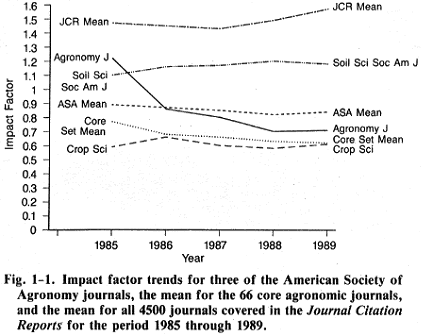
It also is more illuminating to consider trends over several years
rather than rankings in a single year. Figure 1-1 presents impact factor
trends over the 5-yr period from 1985 to 1989. It includes data for each
ASA jour-nal, for the ASA journals as a group, the core set of 66 agronomic
and soil science journals, and the mean for all 4500 journals covered in
the JCR.
You will note that in 1985 the Agronomy Journal had the highest impact
of the ASA journals at 1 .2, well above the ASA mean of 0.9 and the core
set mean of 0.8. But by 1989, its impact had slipped to 0.7, slightly below
the ASA mean of 0.8, but still higher than the core set mean of 0.6. The
Soil Science Society of America Journal slightly improved its impact factor
from 1.1 in 1985 to 1 .2 in 1989, while Crop Science maintained its impact
at 0.6 with only slight fluctuation during this period. In comparison
, the mean impact for the entire core set deteriorated from 0.8 in 1985
to 0.6 in 1989.

Figure 1-2 shows impact factor trends for the ASA journals compared
against that of the core set. That is, the mean impact for the core agronomic
and soil science journals has been set as a constant value of 1.0 for the
5-yr period. This allows us to see more clearly the per-formance of the
ASA journals relative to the core set.
The Soil Science Society of America Journal shows the greatest gain
relative to the core set mean. In 1985, its impact was 43% greater than
the core mean, and by 1989 it was 90% greater. Crop Science also shows
a gain, from 23% under the core set mean impact to equaling the core set
impact in 1989. But the trend for the Agronomy Journal is the reverse�from
having 58% greater impact than the core set in 1985 to 15% higher impact
in 1989.
Let�s now briefly compare the impact of another ASA publication,
the Journal of Environmental Quality, to other ISI-indexed environmental
science journals. Table 1-5 shows 24 environmental science journals that
had an impact of at least 1 .00 in 1989. Environmental Science and Technology,
published by the American Chemical Society, has the highest impact at 2.89.
The Journal of Environmental Quality ranks 11th with an impact of 1.20.
The average impact for all 60 environmental science journals indexed in
the SCI that year was 1.02.
|
|
Figure 1-3 shows impact factor trends for the environmental science
journals and the JCR as a whole. The Journal of Environmental Quality had
an impact factor of 1 .5 in 1985, which dropped to 1.1 by 1987, increased
to 1 .3 the following year before slipping slightly to 1.2 in 1989. The
average impact for the 60 core environmental science journals declined
slightly from 1.1 in 1985 to 1 .0 in 1989. |
|
|
In Figure 1-4, the mean impact for the core will be set at 1.00 for
the 5-yr period to compare the Journal of Environmental Quality against
it. As you can see, the impact of the Journal of Environmental Quality
in 1985 was 35% higher than that of the core set of 60 environmental science
journals. By 1987 its impact equaled that of the core set, then increased
to 30% greater in 1988 before winding up 18% higher in 1989. |
THE MACROJOURNAL OF AGRONOMY: WHAT IT CITES
As stated earlier, the 66 core agronomic and soil science journals can
be treated as if they comprised a single Macrojournal of Agronomy to see
what it cites and, conversely, what cites it. In 1989, the core set published
6608 articles, or 1 .3% of the more than 507 000 articles included in the
JCR database that year. These articles cited 122 453 references to over
22 000 journals, representing 1.5% of the 8.4 million citations included
in the JCR that year.
Table 1-6 shows the 25 journals that were most cited by the core, in
descending order of total core citations received, shown in Column A. The
table also gives data on total citations received from all journals (Column
B); the number of times each journal cited itself, or self citations (Column
C); the percentages of core-to-total (D), self-to-total (E), and self-to-core
(F) citations; 1989 im pact factors (G); 1989 immediacy indexes (H), or
the average number of times a journal�s 1989 articles were cited in 1989;
and the number of source items published in 1989 (I).
Table 1-6. The 25 journals most cited by
the core agriculture journals, 1989 SCI.
|
| |
A�
|
B
|
C
|
D
|
E
|
F
|
G
|
H
|
I
|
|
| Soil Science Society of America Journal� |
4 833
|
7 204
|
1 623
|
67.1
|
22.5
|
33.6
|
1.19
|
0.26
|
330
|
| Agronomy Journal� |
2 913
|
4 364
|
689
|
66.8
|
15.8
|
23.7
|
0.71
|
0.21
|
173
|
| Crop Science� |
2 591
|
4 709
|
1 320
|
55.0
|
28.0
|
50.9
|
0.61
|
0.16
|
427
|
| Soil Science� |
1 740
|
2 902
|
212
|
60.0
|
7.3
|
12.2
|
0.65
|
0.16
|
116
|
| Journal of Economic Entomology� |
1 663
|
4 237
|
1 201
|
39.2
|
28.3
|
72.2
|
0.74
|
0.14
|
326
|
| Plant and Soil� |
1 628
|
3 249
|
550
|
50.1
|
16.9
|
33.8
|
0.69
|
0.14
|
309
|
| Soil Biology and Biochemistry� |
1 609
|
2 673
|
632
|
60.2
|
23.6
|
39.3
|
1.31
|
0.27
|
171
|
| Transactions of the American Society of
Agricultural Engineers� |
1 498
|
1 986
|
837
|
75.4
|
42.1
|
55.9
|
0.37
|
0.08
|
277
|
| Agricultural and Biological Chemistry
(Tokyo)� |
1 463
|
6 416
|
1 267
|
22.8
|
19.7
|
86.6
|
0.86
|
0.32
|
625
|
| Journal of Agricultural and Food Chemistry� |
1 298
|
5 999
|
698
|
21.6
|
11.6
|
53.8
|
1.20
|
0.20
|
340
|
| Plant Physiology |
1 124
|
20 333
|
--
|
5.5
|
--
|
--
|
2.84
|
0.42
|
754
|
| Weed Science� |
1 027
|
1 625
|
642
|
63.2
|
39.5
|
62.5
|
0.59
|
0.16
|
116
|
| Journal of Biological Chemistry |
984
|
183 385
|
--
|
0.5
|
--
|
--
|
6.64
|
0.97
|
3 292
|
| Journal of Soil Science� |
984
|
1 451
|
234
|
67.8
|
16.1
|
23.8
|
0.95
|
0.27
|
77
|
| Australian Journal of Agricultural Research� |
937
|
1 885
|
332
|
49.7
|
17.6
|
35.4
|
0.74
|
0.30
|
120
|
| Journal of Agricultural Science� |
918
|
2359
|
187
|
38.9
|
7.9
|
20.4
|
0.49
|
0.06
|
107
|
| Journal of Environmental Quality |
803
|
1 867
|
--
|
43.0
|
--
|
--
|
1.20
|
0.26
|
94
|
| Journal of the Science of Food and Agriculture� |
773
|
2 835
|
265
|
27.3
|
9.3
|
34.3
|
0.68
|
0.19
|
182
|
| Nature |
752
|
178 265
|
--
|
0.4
|
--
|
--
|
18.06
|
4.21
|
1 045
|
| Phytopathology |
744
|
7 190
|
--
|
10.3
|
--
|
--
|
1.51
|
0.27
|
236
|
| Applied Environmental Microbiology |
688
|
12 251
|
--
|
5.6
|
--
|
--
|
2.43
|
0.32
|
584
|
| Canadian Journal of Soil Science� |
688
|
971
|
206
|
70.9
|
21.2
|
29.9
|
0.73
|
0.10
|
90
|
| Science |
655
|
117 063
|
--
|
0.6
|
--
|
--
|
18.26
|
3.61
|
829
|
| Agronomy |
587
|
707
|
--
|
83.0
|
--
|
--
|
NA
|
NA
|
0
|
| Journal of Food Science |
534
|
5681
|
--
|
9.4
|
--
|
--
|
0.80
|
0.12
|
427
|
� Core journal. |
| � A = citations from core journals; B =
citations from all journals; C = self-citations; D = percentage of total
citations that are core� journal citations (A/B); E = percentage of total
citations that are self-citations (self-citing rate, C/B); F = percentage
of core�journal citations that are self-citations (C/A); G = 1989
impact factor; H = 1989 immediacy index; and I = total 1989 source items. |
These 25 journals received 33 434 citations from the Macrojournal of
Agronomy, or 27.3% of all citations it gave out in 1989. Sixteen of the
journals listed are themselves core journals. They are indicated by daggers.
The three journals at the top of the list are all ASA publications�the
Soil Science Society of America Journal is first with 4833 citations from
the core followed by Agronomy Journal with 2913 and Crop Science with 2591
. The Journal of Environmental Quality also appears and ranks 17th on the
list of journals most cited by the core.
Plant Physiology is the leading noncore journal cited most frequently
by the Macrojournal of Agronomy. It received 1 124 core citations in 1989,
which amounts to 5.5% of the more than 20 000 citations this journal received
from all publications in the 1989 JCR database. Two leading multidisciplinary
journals, Nature and Science, are also listed. For these journals, core
citations represent less than 0.6% of total citations received. That is,
the Macrojournal of Agronomy is selectively citing the fraction of the
literature in Nature and Science that is relevant to its interests.
These and other leading multidisciplinary journals, such as the Proceedings
of the National Academy of Sciences of the United States (PNAS), have consistently
appeared in lists of journals most cited by various specialty journal sets.
This reflects their key position in scientific communication across many
disciplines.
WHAT CITES THE MACROJOURNAL OF AGRONOMY
Table 1-7 shows 25 journals that most frequently cited the core agronomic
and soil science journals in 1989, in descending order of citations to
the core. The Macrojournal of Agronomy received more than 73751 citations
from 1425 journals in 1989. The 25 journals listed here cited the core
28946 times, accounting for 39.2% of total citations received by the core.
Table 1-7. The 25 journals
that most frequently cited the core agriculture journals, 1989 SCI.
|
| |
A�
|
B
|
C
|
D
|
E
|
F
|
G
|
H
|
I
|
|
| Soil Science Society of America Journal� |
3 539
|
7 566
|
1 623
|
46.8
|
21.5
|
45.9
|
1.19
|
0.26
|
330
|
| Crop Science� |
2 232
|
5 623
|
1 320
|
39.7
|
23.5
|
59.1
|
0.61
|
0.16
|
427
|
| Plant and Soil� |
1 937
|
6 491
|
550
|
29.8
|
8.5
|
28.4
|
0.69
|
0.14
|
309
|
| Agronomy Journal� |
1 542
|
3 259
|
689
|
47.3
|
21.1
|
44.7
|
0.71
|
0.21
|
173
|
| Journal ofEconomic Entomology� |
1 521
|
5 466
|
1 201
|
27.8
|
22.0
|
79.0
|
0.74
|
0.14
|
326
|
| Soil Biology and Biochernistry� |
1 454
|
3 882
|
632
|
37.5
|
16.3
|
43.5
|
1.31
|
0.27
|
171
|
| Agricultural and Biological
Chemistry (Tokyo)� |
1 379
|
9 394
|
1 267
|
14.7
|
13.5
|
91.9
|
0.86
|
0.32
|
625
|
| Transactions of the American
Society of Agricultural Engineers� |
1 344
|
4 049
|
837
|
33.2
|
20.7
|
62.3
|
0.37
|
0.08
|
277
|
| Journal of Agricultural and
Food Chemistry� |
1 194
|
6 868
|
698
|
17.4
|
10.2
|
58.5
|
1.20
|
0.20
|
340
|
| Communications in Soil Science
and Plant Analysis� |
1 084
|
2 271
|
153
|
47.7
|
6.7
|
14.1
|
0.47
|
0.05
|
134
|
| Biology and Fertility of Soils� |
1 021
|
2 796
|
76
|
36.5
|
2.7
|
7.4
|
0.79
|
0.13
|
111
|
| Canadian Journal of Soil Science� |
960
|
1 831
|
206
|
52.4
|
1 1.3
|
21.5
|
0.73
|
0.10
|
90
|
| Soil Science� |
960
|
2 150
|
212
|
44.7
|
9.9
|
22.1
|
0.65
|
0.16
|
116
|
| Weed Science� |
929
|
2 368
|
642
|
39.2
|
27.1
|
69.1
|
0.59
|
0.16
|
116
|
| Journal of Soil Science� |
914
|
1923
|
234
|
47.5
|
12.2
|
25.6
|
0.95
|
0.27
|
77
|
| Australian Journal of Agricultural
Research� |
891
|
2 780
|
332
|
32.1
|
1 1.9
|
37.3
|
0.74
|
0.30
|
120
|
| ACS Symposium Series |
809
|
25 203
|
-
|
3.2
|
-
|
-
|
0.90
|
0.17
|
869
|
| Journal ofEnvironmental Quality |
750
|
2 503
|
-
|
30.0
|
-
|
-
|
1.20
|
0.26
|
94
|
| Soil and Tillage Research� |
738
|
1 322
|
98
|
55.8
|
7.4
|
13.3
|
0.53
|
0.13
|
63
|
| Canadian Journal of Plant Science |
680
|
2 682
|
-
|
25.4
|
-
|
-
|
0.44
|
0.12
|
162
|
| Australian Journal of Soil
Research� |
672
|
1 395
|
169
|
48.2
|
12.1
|
25.1
|
0.84
|
0.41
|
63
|
| Applied Environmental Microbiology |
623
|
15 482
|
-
|
4.0
|
-
|
-
|
2.43
|
0.32
|
584
|
| Field Crops Research� |
607
|
1 321
|
102
|
46.0
|
7.7
|
16.8
|
0.63
|
0.35
|
69
|
| Journal of Food Science |
593
|
8 658
|
-
|
6.8
|
-
|
-
|
0.80
|
0.12
|
427
|
| Euphytica� |
573
|
2 847
|
193
|
20.1
|
6.8
|
33.7
|
0.39
|
0.13
|
168
|
� Core journal. |
| � A = citations from core journals;
B = citations from all journals; C = self-citations; D = percentage of
total citations that are core-journal citations (A/B); E = percentage of
total citations that are self-citations (self-cited rate, C/B); F = percentage
of core-journal citations that are self-citations (C/A); G = 1989 impact
factor; H = 1989 immediacy index; and I = total 1989 source items. |
Twenty of the journals listed are core journals, and they are indicated
by daggers. Again, the ASA journals dominate in terms of the number of
times they cited the core. The Soil Science Society of America Journal
is first with 3539 citations to the core, followed by Crop Science (2232
citations), Plant and Soil (published by Kiuwer, 1937 citations), and Agronomy
Journal(1542). The Journal of Environmental Quality ranks 18th with 750
citations to the core in 1989.
These data indicate that ASA publications are among the journals most
closely tied to the agronomic and soil science literature. That is, ASA
journals are among the heaviest �consumers� of agronomic and soil science
research.
CITATION CLASSICS IN THE AGRONOMIC SCIENCES
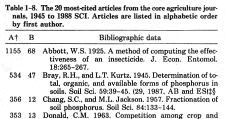 Table
1-8 presents 20 articles from the core journals that were most cited in
the 1945 to 1988 SCI database. These articles can be considered a sample
representing topics that have proven to be of the widest interest or application
in the field of agronomy and soil science. The most cited article is a
1925 Journal of Economic Entomology paper by W.S. Abbott, Bureau of Entomology,
USDA. It described a method for calculating the effectiveness
of an insecticide and received 1155 citations during the period
1945 to 1988. It was cited 68 times in 1989, indicating continued interest
in the method described.
Table
1-8 presents 20 articles from the core journals that were most cited in
the 1945 to 1988 SCI database. These articles can be considered a sample
representing topics that have proven to be of the widest interest or application
in the field of agronomy and soil science. The most cited article is a
1925 Journal of Economic Entomology paper by W.S. Abbott, Bureau of Entomology,
USDA. It described a method for calculating the effectiveness
of an insecticide and received 1155 citations during the period
1945 to 1988. It was cited 68 times in 1989, indicating continued interest
in the method described.
Four papers in Table 1-8 were published in ASA journals. Two appeared
in Crop Science [see Eberhart & Russell (1966), and Fehr et al. (1971)],
one in Soil Science Society of America Journal [Lindsay & Norvell (1978),
and another in the Soil Science Society of America Proceedings [Watanabe
& Olsen (1965)].
Seven papers have been the subject of Citation Classic commentaries
written by the authors and published in Current Contents (CC). They are
indicated by double daggers; and the issue, year, and edition of CC in
which they appeared follow the reference in parentheses. These commentaries
can be considered minibiographies of now classic research, in which the
authors describe their work as well as the circumstances that led to its
development and publication.
Tables 1-9 to 1-12 present the 20 most cited articles from the ASA journals
included in this study, respectively, Agronomy Journal, Crop Science, Journal
of Environmental Quality, and Soil Science Society of America Journal.
CURRENT RESEARCH FRONTS IN THE AGRONOMIC SCIENCES
Another perspective on current topics of particular
interest in the agronomic sciences can be gained from ISI�s 1989 file of
thousands of so-called research fronts. These are automatically generated
by a method called cocitation cluster analysis. The method has been described
in detail previously, and interested readers should refer to these publications
(3 , 4).
Briefly put, the method takes the reference list of a paper and pairs
each of the citations with one another. The computer then searches for
other papers that cocite the same pairs of papers, thereby creating a cluster
of research linked by cocitation. The cited papers constitute the core
of the cluster while the citing papers make up the current research front.
The names of the research fronts are automatically derived from the words
and phrases in the titles of the citing papers.
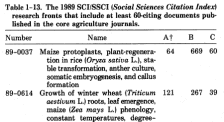 Table
1-13 shows 12 1989 research fronts that included at least 60-citing articles
from the core agronomic and soil science journals in this study. The most
active research front, in terms of the number of citing articles from the
Macrojournal of Agronomy, is no. 89-0614, �Growth of winter wheat roots,
leaf emergence, maize phenology, constant temperatures, degree-day model,
and dry-matter accumulation.� It includes 121-citing papers from core journals,
which amount to 45.3% of all 267-citing papers in this research front.
Of these, 33 were published in ASA journals. Next is no. 89-1087, �Bradyrhi
zobium japonicum strains for nodulation, nitrogenase activity, N2 fixation
in Thai soybean, and narrow-leafed lupin (Lupinus angustifolius L.),� with
120-citing articles from the core journals, of which 14 were ASA journal
articles.
Table
1-13 shows 12 1989 research fronts that included at least 60-citing articles
from the core agronomic and soil science journals in this study. The most
active research front, in terms of the number of citing articles from the
Macrojournal of Agronomy, is no. 89-0614, �Growth of winter wheat roots,
leaf emergence, maize phenology, constant temperatures, degree-day model,
and dry-matter accumulation.� It includes 121-citing papers from core journals,
which amount to 45.3% of all 267-citing papers in this research front.
Of these, 33 were published in ASA journals. Next is no. 89-1087, �Bradyrhi
zobium japonicum strains for nodulation, nitrogenase activity, N2 fixation
in Thai soybean, and narrow-leafed lupin (Lupinus angustifolius L.),� with
120-citing articles from the core journals, of which 14 were ASA journal
articles.
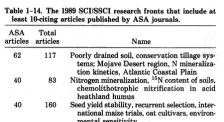 Table
1-14 identifies 31 1989 research fronts that included at least 10-citing
articles published in ASA journals. These will indicate research areas
in which the ASA is most active, again in terms of number of citing articles.
Table
1-14 identifies 31 1989 research fronts that included at least 10-citing
articles published in ASA journals. These will indicate research areas
in which the ASA is most active, again in terms of number of citing articles.
 Table
1-15 provides another view on areas of special interest to ASA authors.
It ranks research fronts by the proportionate share of total citing articles
that were published in ASA journals.
Table
1-15 provides another view on areas of special interest to ASA authors.
It ranks research fronts by the proportionate share of total citing articles
that were published in ASA journals.
CONCLUSIONS
Various citation data have been considered to deter-mine which agronomic
and soil science journals indexed in the 1989 SCI can be said to occupy
a prominant position within the field. These include impact
factors, citations received by the set of 66 core journals, and citations
to the core. Eight of the sixty-six core journals ranked among the top
15 on all three of these indicators. They are: Agricultural and Biological
Chemistry (Tokyo), Agronomy Journal, Australian Journal of Agricultural
Research, Journal of A gricultural and Food Chemistry, Journal of Economic
Entomology, Journal of Soil Science, Soil Biology and Biochemistry, and
Soil Science Society of America Journal. In addition, two journals ranked
among the top 15 in terms of impact factors and citations to the core,
but not citations from the core. They are: Biology and Fertility of Soils
and Canadian Journal of Soil Science.1
Of course, agronomists and soil scientists also rely on large multidisciplinary
journals such as Nature, Science and PNAS, as do researchers in other specialties.
Other more specialized journals covering broad fields, such as biochemistry,
that are relevant to the agronomic sciences are also important. Nevertheless,
the 11 agronomic and soil science journals identified above may be considered
the most prominent vehicles of research communication in this specialty.
The ASA�s impression that its publications are among the �premier�
journals in the field is confirmed by the citation data presented here
since all three ASA journals are included among these 11.
REFERENCES
1. back to
text Garfield, E. 1986. Which medical journals have the
greatest impact? Ann. Intern. Med. 105:313�320. pdf
file available
2. back to textGarfield,
E. 1981. Bradford�s law and related statistical patterns. p. 476�483. In
E. Garfield (ed.) Essays of an information scientist. Vol. 4. ISI Press,
Philadelphia. pdf
file available
3. back to textSmall,
H., and E. Sweeney. 1985. Clustering the Science Citation Index using co-citations.
I. A comparison of methods. Scientometrics 7:391�409.
4. back to textSmall,
H., E. Sweeney, and E. Greenlee. 1985. Clustering the Science Citation
Index using co-citations. II. Mapping science. Scientometrics 8:321�340.
Editors� note:
1 back to
text Crop Science ranked 2nd and 3rd in terms of citations
to the core and from the core, respectively, but its impact was 23rd in
the list of core journals.
 Table
1-1 lists 66 agronomic and soil science journals covered in the Journal
Citation Reports (JCR) volumes of the 1989 SCI, in alphabetic order by
publisher and showing their first years of publication. The oldest is Journal
of Agronomy and Crop Science/Zeitschrift für Acker- und Pflanzenbau,
which was launched in 1853. Others are: Journal of Agricultural Science
(1905);
Transactions
of the ASAE (American Society of Agricultural Engineers) and the ASA�s
Agronomy Journal (both 1907); and the Journal of Economic Entomology
(1908).
Table
1-1 lists 66 agronomic and soil science journals covered in the Journal
Citation Reports (JCR) volumes of the 1989 SCI, in alphabetic order by
publisher and showing their first years of publication. The oldest is Journal
of Agronomy and Crop Science/Zeitschrift für Acker- und Pflanzenbau,
which was launched in 1853. Others are: Journal of Agricultural Science
(1905);
Transactions
of the ASAE (American Society of Agricultural Engineers) and the ASA�s
Agronomy Journal (both 1907); and the Journal of Economic Entomology
(1908).





